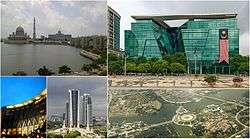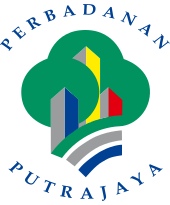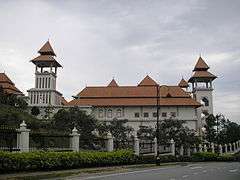Putrajaya
| Putrajaya Prang Besar / Air Hitam | |||
|---|---|---|---|
| Federal Territory | |||
|
Federal Territory of Putrajaya Wilayah Persekutuan Putrajaya 布城联邦直辖区 ولايه ڤرسكوتوان ڤوترا جاي புத்ராஜாயா | |||
| Other transcription(s) | |||
| • Malay | Putrajaya | ||
| • Jawi | ڤوتراجاي | ||
| • Chinese | 布城 | ||
| • Tamil | புத்ராஜெயா | ||
|
Top left to right: Putra Mosque and Perdana Putra, Ministry of Health building Bottom left to right: Ministry of Finance Complex, Putrajaya, high rise ministry complexes, Putrajaya's Presint 1 from above | |||
| |||
|
Motto: Bandar raya Taman, Bandar raya Bestari (Garden City, Intelligent City) | |||
.svg.png) Putrajaya in Malaysia | |||
| Coordinates: 2°56′35″N 101°41′58″E / 2.9430952°N 101.699373°ECoordinates: 2°56′35″N 101°41′58″E / 2.9430952°N 101.699373°E | |||
| Country |
| ||
| Establishment | 19 October 1995 | ||
| Granted Federal Territory | 1 February 2001 | ||
| Government | |||
| • Administered by | Putrajaya Corporation | ||
| • Chairman | Hasim Ismail | ||
| Area[1] | |||
| • Total | 49 km2 (19 sq mi) | ||
| Population (2015)[2] | |||
| • Total | 88,300 | ||
| • Density | 1,800/km2 (4,700/sq mi) | ||
| Time zone | MST (UTC+8) | ||
| • Summer (DST) | Not observed (UTC) | ||
| Postcode | 62xxx | ||
| Calling code | +603-88 | ||
| ISO 3166 code | MY-16 | ||
| Mean solar time | UTC+06:46:40 | ||
| Vehicle registration | F | ||
| Website |
www | ||
Putrajaya (/pʊtrɑːdʒɑːjə/), officially the Federal Territory of Putrajaya, is a planned city and the federal administrative centre of Malaysia. The seat of government was shifted in 1999 from Kuala Lumpur to Putrajaya, because of overcrowding and congestion in the former. Kuala Lumpur remains Malaysia's national capital, and is the seat of the King and the Parliament, and is the country's commercial and financial centre. Putrajaya was the idea of former Prime Minister Mahathir Mohamad. It became Malaysia's third Federal Territory, after Kuala Lumpur and Labuan, in 2001.
Named after the first Malaysian Prime Minister, Tunku Abdul Rahman Putra, the territory is entirely enclaved within the Sepang District of the state of Selangor. Putrajaya is also a part of MSC Malaysia, a special economic zone that covers Klang Valley. In Sanskrit, "putra" means "prince" or "male child", and "jaya" means "success" or "victory". The development of Putrajaya started in the early 1990s; today, major landmarks have been completed and the population is expected to grow in the near future.
History and design
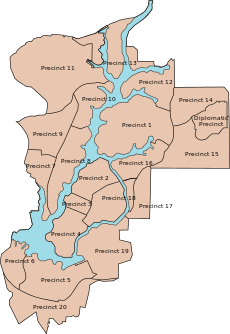
Putrajaya used to be Prang Besar ('ڤراڠ بسر), and was founded in 1918 as Air Hitam by the British. Its land area of 800 acres (3.2 km2) d expanded to 8,000 acres (32 km2), and it was merged with surrounding estates, including Estet Raja Alang, Estet Galloway and Estet Bukit Prang.
The vision of a new Federal Government Administrative Centre to replace Kuala Lumpur as the administrative capital emerged in the late 1980s, during the tenure of Malaysia's fourth prime minister, Mahathir bin Mohamad. The new city was proposed to be located between Kuala Lumpur and the new Kuala Lumpur International Airport (KLIA). Two areas were proposed: Prang Besar and Janda Baik of Pahang.[3]
The Federal government negotiated with the state of Selangor on the prospect of another Federal Territory. In the mid-1990s the Federal government paid a substantial amount of money to Selangor for approximately 11,320 acres (45.8 km2) of land in Prang Besar, Selangor. As a result of this land purchase, the state of Selangor now completely surrounds two Federal territories within its borders, namely Kuala Lumpur and Putrajaya.
Planned as a garden city and intelligent city, 38% of the area is reserved for green spaces in which the natural landscape is enhanced. The plan incorporated a network of open spaces and wide boulevards. Construction began in August 1995; it was Malaysia's biggest project and one of Southeast Asia's largest, with an estimated final cost of US$8.1 billion. The entire project was designed and constructed by Malaysian companies with only 10% of the materials imported.
The Asian Financial Crisis of 1997/1998 somewhat slowed the development of Putrajaya. 300 members of the Prime Minister's office staff moved there in 1999, and the remaining government servants moved in 2005. On 1 February 2001 Prime Minister Mahathir declared Putrajaya as a Federal Territory in a ceremony by which Putrajaya township was handed over from the Selangor state authorities.
In 2002 a rail link called KLIA Transit was opened, linking Putrajaya to KLIA in Sepang. However, construction of the Putrajaya Monorail, which was intended to be the city's metro system, was suspended owing to high costs. One of the monorail suspension bridges in Putrajaya remains unused.
In April 2013 the Putrajaya government signed a letter of intent (LOI) with the government of Sejong City in South Korea to mark co-operation between the two cities.[4]
Government and infrastructure
As of 2012 almost all of Malaysia's governmental ministries had relocated to Putrajaya. The only ministries remaining in Kuala Lumpur were the Ministry of International Trade and Industry (Malaysia), Ministry of Defence and Ministry of Works.[5] Alamanda Shopping Centre, located near the governmental ministries in Precinct 1, was opened to serve people who work, play and live in Putrajaya.
Demographics
Population
In 2007 the population of Putrajaya was estimated to be over 30,000, which comprised mainly government servants. Government servants have been encouraged to relocate to the city through a variety of government subsidy and loan programs. The population had increased to 88,300 by 2015.[2]
Religious Demography
As of 2010, the population of Putrajaya is 97.4% Muslim, 0.9% Christian, 0.4% Buddhist, 1.0% Hindu, 0.2 % unknown and 0.1% other religion.
Public buildings and monuments

- Perdana Putra – office of the Prime Minister
- Seri Perdana – official residence of the Prime Minister
- Sri Satria – official residence of the Deputy Prime Minister
- Palace of Justice
- Ministry of Finance
- Wisma Putra – Malaysian Ministry of Foreign Affairs.
- Melawati National Palace
- Istana Darul Ehsan
- Putrajaya International Convention Centre
- Perdana Leadership Foundation
- Heritage Square
- Selera Putra
- Souq Putrajaya
- Pusat Kejiranan Presint 9
- Pusat Kejiranan Presint 16
- Putra Mosque
- Tuanku Mizan Zainal Abidin Mosque (Iron Mosque (Masjid Besi))
- Monuments
Open space
- Putrajaya Lake
- Putra Square
- Putrajaya Wetlands Park
- Taman Selatan
- Putrajaya Botanical Gardens – The biggest botanical garden in Malaysia, covering an area over 92 hectares[7]
Education
Kindergarten and Pre-School
- Brainy Bunch International Montessori (Presint 14)
- Government Pre-School (Pra-Sekolah) located in Primary School.
Primary & Secondary Education in Putrajaya is provided by a few schools such as:
- SMK Putrajaya Presint 8 (1)
- SMK Putrajaya Presint 9.
- SMK Putrajaya Presint 16(1).
- SMK Putrajaya Presint 11(1).
- SMK Putrajaya Presint 9(2).
- SMK Putrajaya Presint 14(1).
- SMK Putrajaya Presint 11(2).
- SMK Putrajaya Presint 18(1).
- SMK Putrajaya Presint 5(1).
- SK Putrajaya Presint 9(1).
- SK Putrajaya Presint 8(1).
- SK Putrajaya Presint 16(1).
- SK Putrajaya Presint 11(1).
- SK Putrajaya Presint 8(2).
- SK Putrajaya Presint 9(2).
- SK Putrajaya Presint 16(2).
- SK Putrajaya Presint 11(3).
- SK Putrajaya Presint 14(1).
- SK Putrajaya Presint 11(2).
- SK Putrajaya Presint 18(1).
- SK Putrajaya Presint 18(2).
- SK Putrajaya Presint 5(1).
There are also two elite fully residential schools in Putrajaya:
- Sekolah Sultan Alam Shah
- Sekolah Menengah Kebangsaan Agama Putrajaya
Perdana University has established an interim campus in Putrajaya which hosts the Johns Hopkins University School of Medicine (PUGSOM) and the Perdana University-Royal College of Surgeons in Ireland (PU-RCSI) medical schools:
Other universities:
- Heriot-Watt University (Heriot-Watt University Malaysia) has a campus in precinct 5.[8]
Transport
Putrajaya is home to the world's largest roundabout, the Persiaran Sultan Salahuddin Abdul Aziz Shah with a perimeter of 3.5 km. (2.7 miles)
By car
Major highways
Putrajaya is surrounded by federal highways 29 on the western side and 30 on the eastern side. The South Klang Valley Expressway E26, connecting Pulau Indah to Kajang, runs through the northern end of Putrajaya. ELITE E6 exit 607 serves Putrajaya and also nearby Cyberjaya. Highway 29 interchanges with Damansara–Puchong Expressway (LDP) E11 in the northwestern corner of Putrajaya, linking the city with Puchong, Subang Jaya, Kelana Jaya and all the way to Kepong.
Within Putrajaya, the following roads serve as the main thoroughfares of the city.
- Persiaran Persekutuan
- Persiaran Sultan Salahuddin Abdul Aziz Shah (The world's largest roundabout with a diameter of 3.5 km (2.2 miles))
- Persiaran Utara
- Lebuh Sentosa
- Persiaran Barat
- Persiaran Selatan
- Persiaran Timur
- Persiaran Perdana (Boulevard)
List of road bridges

- Seri Perdana Bridge
- Putra Bridge
- Seri Wawasan Bridge
- Seri Bakti Bridge
- Seri Saujana Bridge
- Seri Bestari Bridge
- Seri Setia Bridge
- Seri Gemilang Bridge
Public transport
Rail
The only direct rail connection to Putrajaya is the KLIA Transit line through Putrajaya Sentral, which connects to KL Sentral, Bandar Tasik Selatan, Salak Tinggi, KLIA and Klia2.[9]
Sungai Buloh-Serdang-Putrajaya MRT Line is currently being constructed and will also connect to Putrajaya Sentral as well.[10] Kuala Lumpur–Singapore High Speed Rail will also connect to Putrajaya along the route from Kuala Lumpur to Singapore, but will be located right outside the borders of Putrajaya, nearby Presint 14.
Around 2003, a plan for a monorail in Putrajaya was under construction but was halted due to the stoppage of funding from the government. However, there has been plans to continue the project, or/and constructing a new tram line as well.
Buses
Putrajaya Corporation provides its own stage bus services through its subsidiary Nadi Putra using natural gas-powered buses and a few electric buses. The bus service serves the entirety of Putrajaya as well as Cyberjaya, and provides express bus routes to Kuala Lumpur through Puduraya and a few other nearby cities from its hubs at Putrajaya Sentral and P&R Presint 14.[11] Bus stops in Putrajaya are very common too and serves Nadi Putra. Rapid KL, Metrobus and Cityliner also provides express buses to other areas from Putrajaya Sentral and from bus stops in the city center.
Intercity buses also serve bus routes from Putrajaya Sentral to the northern states.
Politics
Putrajaya is represented in the Dewan Rakyat of the Malaysian Parliament by Tengku Adnan Tengku Mansor of UMNO, part of the Barisan Nasional ruling coalition. Tengku Adnan is also the Minister of Federal Territories.[12]
Being a Federal Territory, Putrajaya does not have a state assembly, and the constituency is not divided into any state seats.
International relations
Twin towns and sister cities
Putrajaya is twinned with these cities:
-
 Cyberjaya, Malaysia
Cyberjaya, Malaysia -
 Sejong City, South Korea[13]
Sejong City, South Korea[13]
Image gallery
- Aerial Photograph - Oct 2013
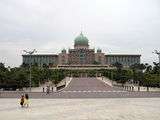 The Prime Minister's office at Perdana Putra
The Prime Minister's office at Perdana Putra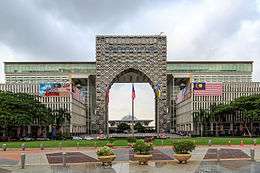 Perbadanan government complex
Perbadanan government complex The Ministry of Finance complex
The Ministry of Finance complex Istana Kehakiman
Istana Kehakiman Putrajaya Walk
Putrajaya Walk- PM Office and Putra Mosque at night
 Interior view of the Seri Wawasan Bridge
Interior view of the Seri Wawasan Bridge Putra Mosque with the Prime Minister's office in the background
Putra Mosque with the Prime Minister's office in the background Seri Saujana Bridge at night
Seri Saujana Bridge at night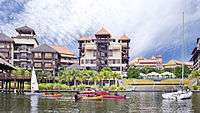 Pullman Putrajaya Lakeside Hotel
Pullman Putrajaya Lakeside Hotel Modern architecture includes streetlamps
Modern architecture includes streetlamps Putrajaya International Convention Centre (PICC)
Putrajaya International Convention Centre (PICC) Ministry of Health Building
Ministry of Health Building Highrises in Precinct 8
Highrises in Precinct 8 Ministry of Agriculture and Agro Based Industry Building
Ministry of Agriculture and Agro Based Industry Building
See also
References
- Citations
- ↑ "Laporan Kiraan Permulaan 2010". Jabatan Perangkaan Malaysia. p. 27. Archived from the original on 8 July 2011. Retrieved 24 January 2011.
- 1 2 "Population by States and Ethnic Group". Department of Information, Ministry of Communications and Multimedia, Malaysia. 2015. Archived from the original on 12 February 2016. Retrieved 12 February 2015.
- ↑ (in Malay)Abdullah, Hasfiza (February 2012). DARI PRANG BESAR KE PUTRAJAYA. Dewan Bahasa dan Pustaka. Retrieved 26 October 2015.
- ↑ "Closer ties between Putrajaya and Sejong, Korea". (Archived from the original) The Star (Malaysia). Saturday 6 April 2013. Updated on Friday 26 April 2013. Retrieved on 1 January 2014.
- ↑ "Malaysian envoy acclaims Sejong City." (Archive) The Korea Times. 23 September 2012.
- ↑ "2010 Population and Housing Census of Malaysia" (PDF) (in Malay and English). Department of Statistics, Malaysia. Archived from the original on 22 May 2014. Retrieved 17 June 2012.
- ↑ "Putrajaya Botanical Garden (Taman Botani)". Tourism Malaysia. Archived from the original on 25 May 2014. Retrieved 25 May 2014.
- ↑ http://www.hw.ac.uk/malaysia.htm
- ↑ Bhd, Express Rail Link Sdn. "KLIAtransit Schedule - KLIA Ekspres". www.kliaekspres.com. Retrieved 2017-03-26.
- ↑ "MYMRT | MRT Corp - Official webpage for the Klang Valley My Rapid Transit.". www.mymrt.com.my. Retrieved 2017-03-26.
- ↑ "PENGANGKUTAN AWAM PUTRAJAYA SDN BHD". www.papsb.com.my. Retrieved 2017-03-26.
- ↑ "Ahli Parlimen". Portal Rasmi Parlimen Malaysia. Retrieved 1 May 2016.
- ↑ Yeen, Oh Ing. "Closer ties between Putrajaya and Sejong, Korea - Community | The Star Online". Retrieved 2017-02-13.
- General
- "Putrajaya presentation". Yangsquare.com. Archived from the original on 10 February 2013. Retrieved 22 January 2014.
Further reading
- King, Ross: Kuala Lumpur and Putrajaya: Negotiating Urban Space in Malaysia, Nias Press, 2008
External links
| Wikimedia Commons has media related to Putrajaya. |
-
 Putrajaya travel guide from Wikivoyage
Putrajaya travel guide from Wikivoyage - Official website
- Tourism Malaysia – Putrajaya
- Traveller's guide to Putrajaya written and maintained by locals
- State Development Office – State Development Office Wilayah Persekutuan
